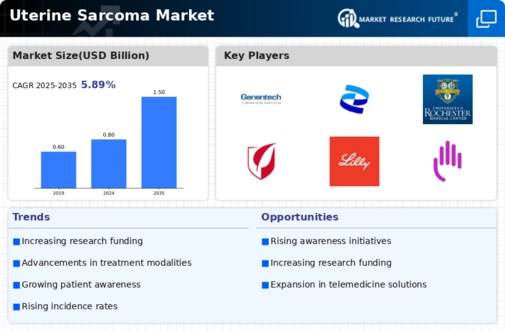Market Growth Projections
The Global Uterine Sarcoma Market Industry is projected to experience substantial growth over the next decade. By 2035, the market is anticipated to reach 1.5 USD Billion, driven by various factors including advancements in treatment options and increased awareness. The expected CAGR of 5.88% from 2025 to 2035 indicates a robust market trajectory, reflecting the ongoing commitment to research and development in this area. This growth presents opportunities for stakeholders to invest in innovative therapies and improve patient outcomes.
Increased Research Funding
Increased funding for research into uterine sarcoma is a critical driver of the Global Uterine Sarcoma Market Industry. Government and private organizations are allocating more resources to understand the biology of this cancer and develop effective treatments. This influx of funding supports clinical trials and research initiatives, which are essential for discovering new therapeutic options. As a result, the market is projected to grow at a CAGR of 5.88% from 2025 to 2035, reflecting the ongoing commitment to advancing knowledge and treatment of uterine sarcoma.
Growing Awareness and Education
The Global Uterine Sarcoma Market Industry benefits from growing awareness and education regarding uterine sarcoma. Campaigns aimed at educating healthcare professionals and the public about the symptoms and risks associated with this cancer are crucial. Increased awareness leads to earlier diagnosis and treatment, which can improve patient outcomes. As more women become informed about uterine sarcoma, the demand for diagnostic and therapeutic services is likely to rise, contributing to market growth and the development of comprehensive care strategies.
Rising Incidence of Uterine Sarcoma
The Global Uterine Sarcoma Market Industry is experiencing growth due to the increasing incidence of uterine sarcoma cases worldwide. As awareness of this rare cancer type rises, more women are being diagnosed, leading to a greater demand for effective treatment options. In 2024, the market is projected to reach 0.8 USD Billion, reflecting a heightened focus on research and development in this area. The growing number of cases necessitates innovative therapies, which may drive investment in clinical trials and new drug development, thereby expanding the market further.
Advancements in Treatment Modalities
Technological advancements in treatment modalities are significantly influencing the Global Uterine Sarcoma Market Industry. Innovations such as targeted therapies, immunotherapy, and personalized medicine are emerging as viable options for patients. These advancements not only improve patient outcomes but also attract investment from pharmaceutical companies aiming to develop new treatments. The market is expected to grow to 1.5 USD Billion by 2035, indicating a robust pipeline of new therapies that could enhance survival rates and quality of life for patients diagnosed with uterine sarcoma.
Emerging Markets and Healthcare Infrastructure
Emerging markets are playing a pivotal role in the expansion of the Global Uterine Sarcoma Market Industry. Countries with developing healthcare infrastructure are increasingly recognizing the need for specialized cancer care. As these nations invest in healthcare systems and improve access to treatment, the market is expected to see significant growth. This trend is particularly relevant as the global healthcare landscape evolves, with a focus on providing comprehensive cancer care to underserved populations, thereby enhancing the overall market potential.























Leave a Comment